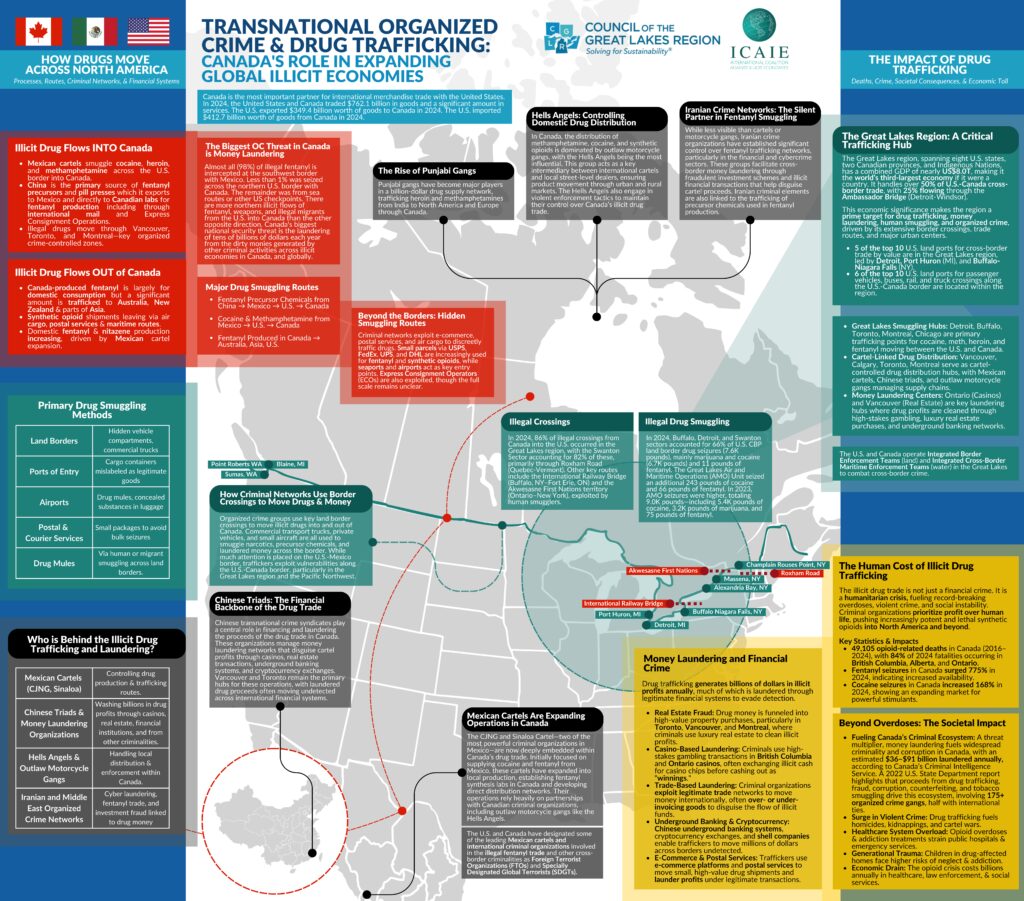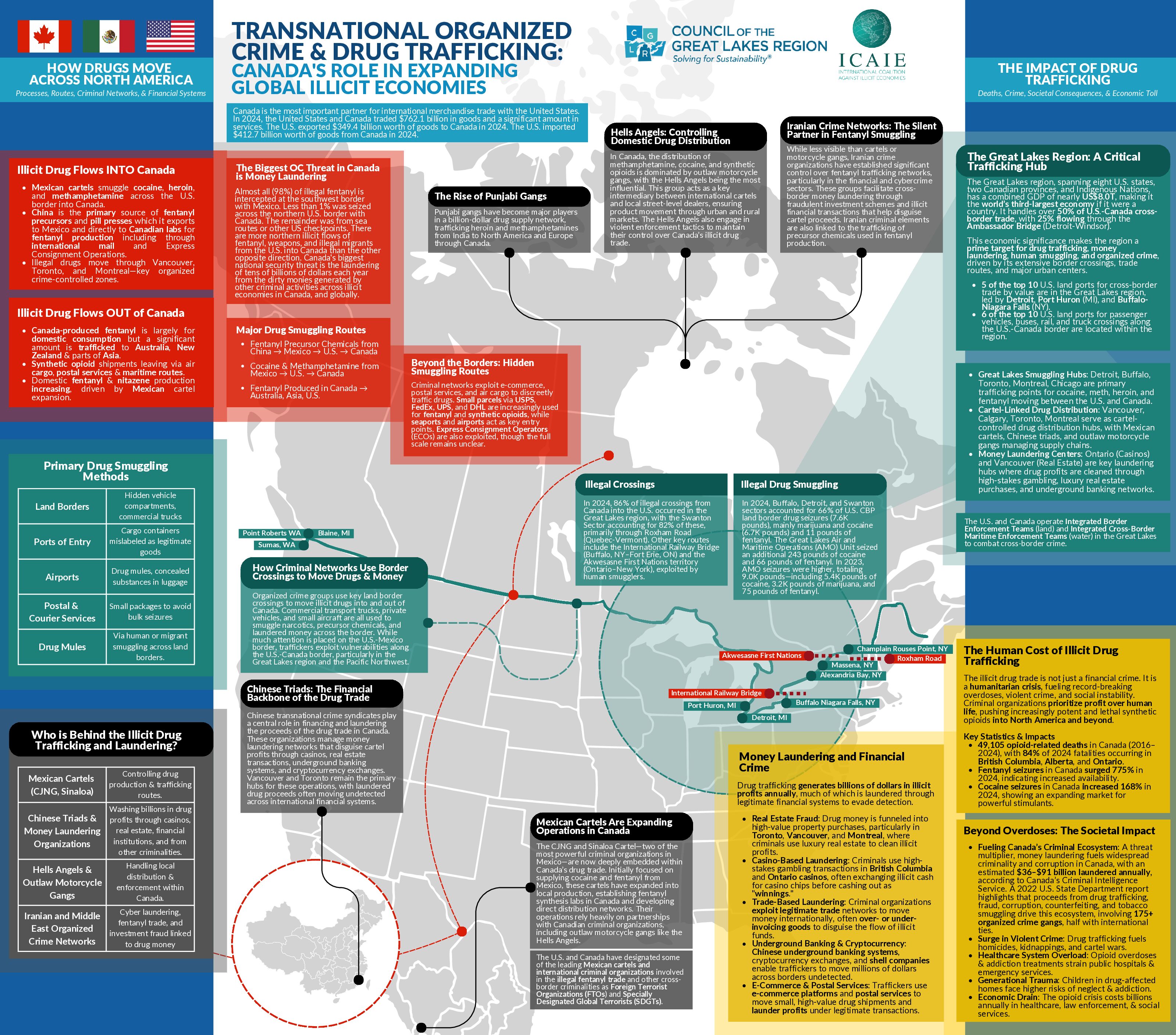Canada Transnational Organized Crime & Drug Trafficking: Canada’s Role in Expanding Global Illicit Economies
“Money laundering is the biggest illicit market and organized crime threat facing Canada.”
— David M. Luna
ICAIE Calls on Canada to Safeguard its National Security by Robustly Combating Cross-Border Illicit Economies, Money Laundering, and Strategic Corruption
Find below new CGLR and ICAIE Infographic on Canada Transnational Organized Crime & Drug Trafficking: Canada’s Role in Expanding Global Illicit Economies.
The U.S. and Canada share one of the most successful and mutually beneficial economic and trade relationships in the world.
However, like other large, transborder economies, both countries are confronting a myriad of inter-connected threats relating to illicit trade, from drug trafficking and organized crime, to human smuggling and money laundering.
This new Infographic from the International Coalition Against Illicit Economies (ICAIE) and the Council of the Great Lakes Region showcases some of these cross-border risks, with a spotlight on the Great Lakes region.
While we remain committed to a targeted focus on fighting the deadly fentanyl trade across North America, the biggest cross-border criminal security threats to Canada and the US are the staggering amounts of dirty money that is laundered in both countries by Mexican cartels, Chinese money laundering syndicates, and other transnational criminal organizations that finance greater insecurity and instability.
CGLR and ICAIE will continue to inform impacted communities across sectors on the harms posed by a convergence of criminalities, corruptive influence, and financial power of today’s international criminal organizations, enabling laundering networks, and malign threat operations.
Stay tuned for more information from ICAIE about the scale of today’s multi-trillion-dollar global illegal economies in Canada, China, Mexico, the US, and around the world, and advance public-private partnerships to counter the pernicious effects of transnational criminal organizations to governance institutions, markets, critical industries, and communities.
Learn more about CGLR: https://lnkd.in/esJxKyee
Learn more about ICAIE: https://icaie.com/

An ICAIE Note: We underscore in this first Phase I of our Canada Illicit Economies Project that there was the dearth of quality data provided by the Government of Canada. As we expand our ICAIE cross-border illicit vectors research in Canada, I was disappointed that besides seizures, we could not get any official data points on estimates for the overall size and scales of today’s illicit markets in Canada and their specific dollar amounts.
What is alarming, nonetheless, is that seizures only show a miniscule level of criminality (and strategic corruption) in Canada, and in fact the scales of illicit markets in Canada are closer to various USG estimates. For example, according to a 2022 report by the U.S. Department of State, tens of billions of dollars are laundered every year in Canada involving the proceeds of illegal drug trafficking, fraud, corruption, counterfeiting and piracy, tobacco smuggling and trafficking, among other illicit activity. While Canadian Security and Intelligence Service (CSIS) has publicly stated a general estimate of $36 billion to $91 billion is being laundered and fully integrated in Canada’s economy annually, there are no specific breakdown per each predicate crime of money laundering or illicit markets. Based on USG and OSINT, we project that the CSIS estimate could very well constitute several times the CSIS value including embezzled funds that are reinvested in Canada that would elevate illicit economies to a few hundreds of billions of dollars that are laundered in the country every year.
A recent investigations at TD Bank, for example, saw the financial institution admitting that its lax anti-money laundering regime allowed fentanyl traffickers to launder at least $670 million, and engaged in numerous other billion-dollar financial crime cases. The earlier Cullen Commission also brought to light the scale of money laundering in Vancouver and other parts of Canada in which criminally-derived dirty monies are reinvested in real estate and other critical industries and sectors in the country.
Taken together, available estimates by both governments in Canada and the United States, it is fair to state that Canada is awash with tens of billions of dirty monies from an array of criminal activities and corruptive influence operations that are laundered and reinvested EVERY YEAR across its formal sectors and industries. As a result, ICAIE opines that money laundering is the biggest illicit market and organized crime threat facing Canada.
“Canada has become a safe zone for the world’s most notorious crime groups and threat networks. It is not merely a consumer of illicit goods and contraband, but increasingly serves as a hub of illicit trade, production and distribution of illicit goods, an exporter of such contraband, and a money laundering safe haven for a potpourri of bad actors and sinister malign networks. Additionally, these illicit activities have a disrupting and destabilizing impact on Canadian political, governance, security, and business structures. In fact, across Canada, criminal networks continue to profit handsomely from an array of illicit activities that are endangering the health and safety of its citizens, and are imperiling the country’s national security, threatening global peace, and financing greater insecurity around the world through the criminality of Mexican cartels, Chinese Triads, Iranian-backed illicit finance networks, and state-sponsored malign influence.” David M. Luna, Executive Director, ICAIE
*****
On February 20, 2025, the U.S. Department of State designated 8 TCOs as Foreign Terrorist Organizations (FTOs) and Specially Designated Global Terrorists (SDGTs) as threats to the safety of the American people, markets, U.S. national security, and the stability of the international order in the Americas: Tren de Aragua, Mara Salvatrucha (MS-13), Cártel de Sinaloa, Cártel de Jalisco Nueva Generación, Cártel del Noreste (formerly Los Zetas), La Nueva Familia Michoacana, Cártel de Golfo (Gulf Cartel), and Cárteles Unidos as FTOs and SDGTs.
Canada has also designated 7 of these cartels as terrorist organizations.
On February 1, 2025, through an Executive Order by President Donald Trump, the United States imposed a 25% additional tariff on imports from Canada and Mexico and a 10% additional tariff on imports from China; energy resources from Canada will have a lower 10% tariff; to encourage more bold actions by Mexico, Canada, and China to halt the poisonous fentanyl and other drugs from flowing into the United States. Regarding Canada, the Executive Order underscored the growing presence of Mexican cartels operating fentanyl and nitazene synthesis labs in Canada. According to the White House, a recent study recognized Canada’s heightened domestic production of fentanyl, and its growing footprint within international narcotics distribution.
Illicit narcotics and opioids kill tens of thousands of Americans each year, including 75,000 deaths per year attributed to fentanyl alone. Canada also incurs thousands of death per year also attributed to fentanyl.


